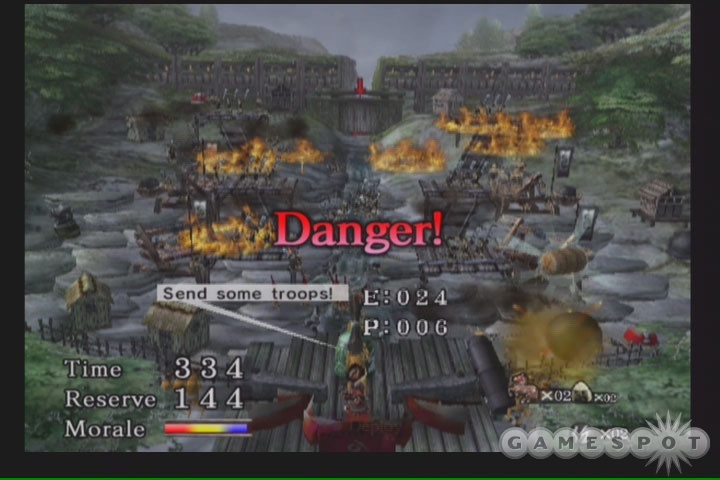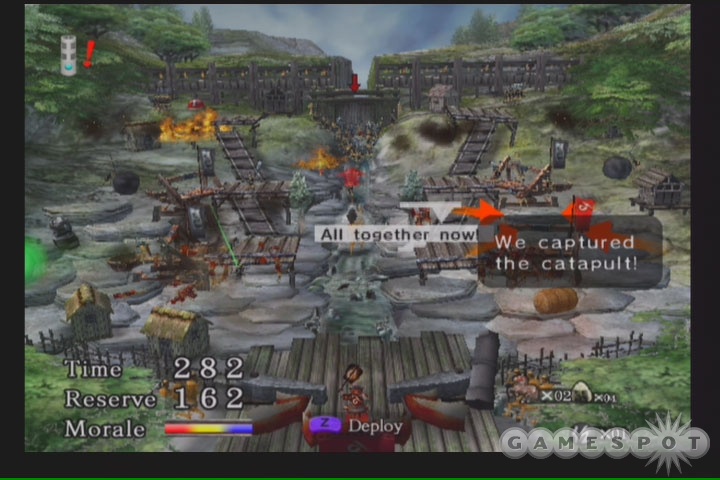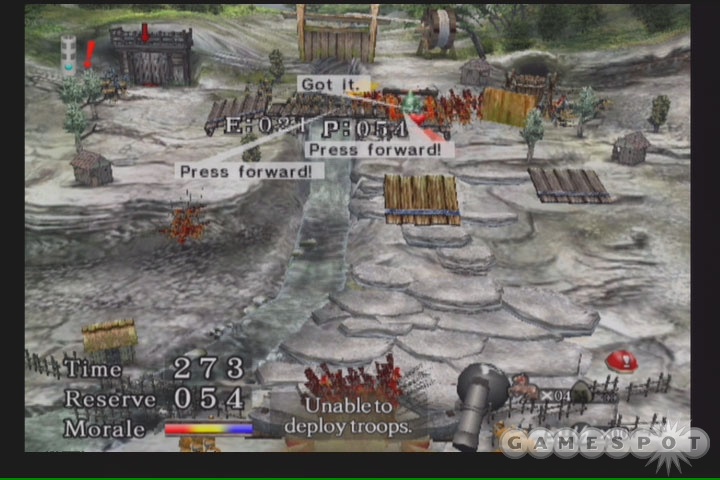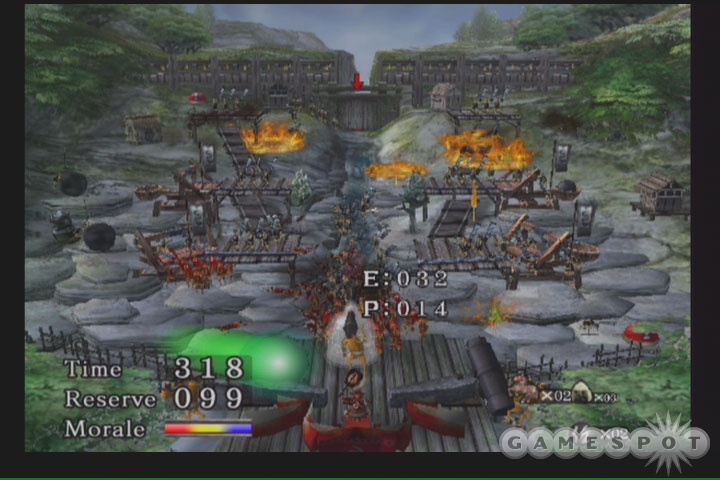Few game designers have proven such an eagerness to disregard the status quo as Yoot Saito. Best known for creating Seaman, the virtual-life simulator for the Dreamcast that saw you engaging in conversation with a bizarre amphibian that looked disturbingly like Yoot himself, he and his development house, Vivarium, have now launched off into a equally bizarre venture with Odama, a strategy game that quite literally turns the battlefields of feudal Japan into a pinball table. If this doesn't sound like the most natural combination, rest assured that it's not. As admirable as it is for a developer to attempt something so totally different, admiration cannot fully compensate for what is an awkward and regularly infuriating experience. Still, there's something to be said for a game with such a fresh perspective, and that novelty will be enough to draw in some people, at least for a while.

Despite the underlying pinball mechanics and the presence of gigantic warlords that tower over the battlefield and crazy spider creatures, Odama presents its feudal Japanese setting with certain sincerity and a convincing backstory. You are Kagetora, a young general out for revenge against a more powerful general who betrayed your father. What you lack in numbers you make up for with two secret weapons. One is the Odama itself, a massive ball that you can launch onto the battlefield, destroying buildings and crushing your enemies. The other is the Ninten Bell, a large hanging bell that you carry out onto the battlefield which, when struck with the Odama, sends out a shockwave that can knock down and stun your enemies. Using these unconventional weapons along with your foot soldiers, cavalry, and giant, flying rice balls, you'll march your way toward revenge across 11 different battlefields.
Besides the game's Bushido aesthetic--which isn't so much technically impressive as it is thorough--the most immediately striking thing about Odama is how much it looks like a pinball table. There's no question that you're looking at battlegrounds of antiquity, but you also can't ignore the gigantic pinball flippers at the bottom of the screen. Though the Odama is pretty good at decimating the opposing forces, brute force alone will not bring you victory. In order to advance, you'll need to carry the Ninten Bell from the bottom of the screen up through a gate at the top, all the while contending with hordes of enemies and their own weapons, which include the conventional and the less than conventional.
While there is only one way to win, there are several ways you can lose. Like in a regular pinball game, it's game over if your last Odama slips down between your flippers. In addition to your swarms of soldiers, you have a dedicated crew that diligently carries the Ninten Bell to the other end of the battlefield. Without proper reinforcements, the opposing armies will push the bell crew down past your flippers, which will also spell defeat. Adding a sense of urgency is a countdown timer that you'll also be racing against--which, surprisingly, led to more defeats for us than the other two methods combined.

You use the left and right triggers on the GameCube controller to activate the left and right flippers accordingly, and the left analog stick can be used to tilt the entire battlefield, giving you a modicum of control over the path of the Odama. As you smash through various structures on the battlefield, you'll come upon a few different power-ups. Hourglasses will increase your timer, and considering how precious time can be in Odama, they are appropriately rare. More common are the giant rice balls, which can be launched back onto the battlefield, thus distracting the apparently famished opposing army.
Of greatest tactical importance, though, are the glowing green orbs and heart power-ups. In its regular form, the Odama is an indiscriminate killer. If it happens to roll over your troops as it makes its way toward its intended target, tough cookies, because you're out a handful of soldiers. But when the Odama rolls over the glowing green orbs, it takes on a green glow of its own, and for a time it not only spares your armies, but also forces any enemy soldiers it rolls over to join your ranks. The heart power-ups are kind of a roundabout version of the green orbs, in that they make the Ninten Bell glow white, and if you ring the Ninten Bell while it's glowing white, you get the awesome green Odama effect.
Soldiers are deployed from between your flippers with a tap of the Z button, but they're not completely autonomous and you retain some general control over them through voice commands. Odama comes with the same GameCube mic found packed in with the past few Mario Party games and Karaoke Revolution Party, as well as a handy little plastic clip that easily mounts on top of the standard GameCube controller or the Wavebird, making it possible to issue voice commands without needing a third hand. Pressing the X button activates the microphone, and your soldiers will respond to around 10 or so different commands. There's no way to command individual troops, and you're instead addressing your army's hive mind with instructions on their aggressiveness and position on the battlefield.

Probably the most specifically useful command is "rally." Most of the battlefields in Odama have strategic structures or items that you can select with the D pad and then tell your troops to rally around, and the results can range from opening up secret side gates to giving you control over the enemy's siege weapons. Voice recognition in games has always been a dicey gimmick at best, but this game has little trouble distinguishing between your commands. Your troops have pretty poor short-term memory, though, and tend to require constant reminders of what to do. Having to repeatedly tell your soldiers to "press forward, press forward, press forward!" gets tiresome within the first few levels.
The number of soldiers you start each level off with is determined by how many soldiers accompanied the bell crew through the gate in the previous level, a system which encourages you to really master a level before you choose to advance, yet has the net effect of punishing the weak. If you don't perform particularly well on one level, the next one is going to be even harder. Additionally, if you beat a level and advance to a new level, only to find it too punishing, the game encourages you to go back and hone your skills on a level you've already beaten. But, if you go back and you lose, the game cuts you off from accessing any levels beyond that, forcing you to replay levels that you've already played through, just to get back to where you were before you started backtracking. This is indicative of the rather unreasonably unforgiving stance that Odama takes throughout.
As a pinball game, Odama is frankly pretty lousy. The Odama is usually slow and cumbersome, though if it hits an object at an odd angle it can suddenly and unpredictably rocket off at high speeds. The physics on the battlefield often feel mechanical, and it's not uncommon to see the Odama get locked into predefined "lanes," or to have the relative gravity of certain areas on the battlefield change without warning. You could try to argue that the pinball deficiencies aren't really relevant since Odama is supposedly a strategy game first and foremost, but the kind of sloppy play that Odama is given undermines a lot of the strategy, too. You can make some basic tactical decisions like where to target the attacks of your Odama or whether your troops should be tending to various rally points or focusing on protecting the bell crew, but the careening Odama tends to shred the best-laid plans, and most of the time all you can really do is keep your ranks up, tell your troops to soldier forward, and hope for the best.

The unmitigated chaos of Odama ultimately doesn't translate into fun, though there is something to be said for the way that chaos is presented. The armies and the pieces of the battlefield don't stand up to close inspection, but they look convincing from the wide angle from which you usually view the battlefield. Adding to the game's authenticity is the wealth of Japanese voice work. You have a faceless adviser who is almost constantly shouting relevant information in your ear in a very stout, commanding male Japanese voice. There's a great din to the battlefield as well, with the constant pulse of huge taiko drums being punctuated with the rallying cries of your armies.
The way that Odama experiments with such disparate elements as real-time strategy, pinball, and voice commands is certainly fascinating, but it's just not a completely successful experiment. The steep learning curve associated with learning how to manage all of the different, often non-traditional control mechanics stymies Odama's potential for broader appeal, and it's ultimately not very fulfilling as a strategy game. The parts that it gets right, like the convincing Shogun presentation, just make the game's missteps that much more prominent.